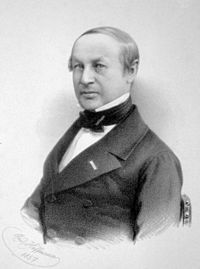
Photo from wikipedia
Intervertebral disc degeneration (IDD) is a public health dilemma as it is associated with low back and neck pain, a frequent reason for patients to visit the physician. During IDD,… Click to show full abstract
Intervertebral disc degeneration (IDD) is a public health dilemma as it is associated with low back and neck pain, a frequent reason for patients to visit the physician. During IDD, nucleus pulposus (NP), the central compartment of intervertebral disc (IVD) undergo degeneration. Stem cells have been adopted as a promising biological source to regenerate the IVD and restore its function. Here, we describe a simple, two‐step differentiation strategy using a cocktail of four factors (LDN, AGN, FGF, and CHIR) for efficient derivation of notochordal cells from human embryonic stem cells (hESCs). We employed a CRISPR/Cas9 based genome‐editing approach to knock‐in the mCherry reporter vector upstream of the 3′ untranslated region of the Noto gene in H9‐hESCs and monitored notochordal cell differentiation. Our data show that treatment of H9‐hESCs with the above‐mentioned four factors for 6 days successfully resulted in notochordal cells. These cells were characterized by morphology, immunostaining, and gene and protein expression analyses for established notochordal cell markers including FoxA2, SHH, and Brachyury. Additionally, pan‐genomic high‐throughput single cell RNA‐sequencing revealed an efficient and robust notochordal differentiation. We further identified a key regulatory network consisting of eight candidate genes encoding transcription factors including PAX6, GDF3, FOXD3, TDGF1, and SOX5, which are considered as potential drivers of notochordal differentiation. This is the first single cell transcriptomic analysis of notochordal cells derived from hESCs. The ability to efficiently obtain notochordal cells from pluripotent stem cells provides an additional tool to develop new cell‐based therapies for the treatment of IDD.
Journal Title: Journal of Cellular Physiology
Year Published: 2019
Link to full text (if available)
Share on Social Media: Sign Up to like & get
recommendations!